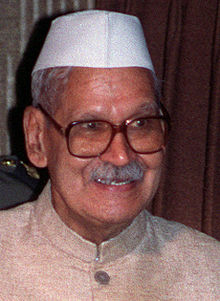Presidential election in India 1992
The 1992 presidential election in India took place on July 13, 1992. It was the tenth presidential election in India since independence. The candidate of the Congress party , Shankar Dayal Sharma, was elected .
prehistory
The term of office of President R. Venkataraman , elected in 1987, ended on July 24, 1987. In the final stages of his term, there was speculation as to whether he would run for a second term. However, Venkataraman declared his disinterest, which is why the search for suitable candidates began. In the Electoral College , which elects the president according to the Indian constitution , three larger political groups were represented, the Congress Party, which provided the Prime Minister of India with PV Narasimha Rao , with its allies, the Bharatiya Janata Party (BJP) and the political parties the National Front under the leadership of Janata Dal together with the communist parties. The proportion of votes in the electoral college was about 3: 2: 1.9, so that none of the groups had an absolute majority. In the run-up to the election, cross-party parliamentarians from the so-called Scheduled Castes (SC) and Scheduled Tribes (ST) demanded that this time a president who should belong to the SC / ST should be elected. VP Singh , the party leader of the Janata Dal , made this demand his own, but also encountered opposition within his own party. The BJP tried to reach an agreement with the Congress party that one of the two posts - President or Vice President - would fall to the BJP. In order to prevent an agreement between the BJP and the Congress Party, the left-wing parties declared that they would elect the previous Vice President, Shankar Dayal Sharma (Congress Party), if KR Narayanan , a member of the scheduled castes , would be elected Vice President with the votes of the Congress Party. The leadership of the Congress party was reluctant to cede the office of vice president to another party, so that the Janata Dal finally nominated George Gilbert Swell , an independent member of the SC, as a presidential candidate. The BJP followed suit. Ram Jethmalani (Janata Dal), a prominent criminal defense attorney and MP in the Rajya Sabha , came up for discussion as another candidate .
Ultimately, most MPs from the Left Front ( CPM , CPI , Forward Bloc , ...) and other regional parties ( AIADMK and others) supported the candidate of the Congress party SD Sharma, BJP and the National Front supported GG Swell. Notwithstanding this, the MPs from the Revolutionary Socialist Party ( Left Front ) and Jharkhand Mukti Morcha ( National Front ) abstained .
Election process and result
The voting weights in the electoral college were based on the 1971 census. The voting weight of the MPs from Lok Sabha and Rajya Sabha was 702. The voting weight of the MPs in the state parliaments was between 7 ( Sikkim ) and 208 ( Uttar Pradesh ). Since the parliaments of Jammu and Kashmir and Nagaland were dissolved at the time of the election, their MPs did not take part in the election.
The election dates were announced on June 10, 1992. Candidate proposals could be submitted until June 24, 1992. On June 25, 1992, a decision was made about the admission of the nominated candidates, who could withdraw their candidacy until June 27, 1992. The actual election took place on July 13, 1992, and the votes were counted on July 16, 1992.
| candidate | Weighted votes | in percent |
|---|---|---|
| Shanker Dayal Sharma | 675,804 | 65.86 |
| George Gilbert Swell | 346,485 | 33.77 |
| Ram Jethmalani | 2,704 | 0.26 |
| Kaka Joginder Singh Urf Dharti-Pakad | 1,135 | 0.11 |
| total | 1,026,188 | 100 |
On July 25, 1992, Sharma took office as president.
Web links
- Election to the Office of the President 2012. (PDF) Indian Election Commission, 2012, accessed on March 27, 2015 (English, detailed explanation of the election process based on the 2012 election).
Individual evidence
- ↑ a b c Election to the Office of the President 2012. (PDF) Indian Election Commission, 2012, accessed on March 27, 2015 (English, detailed explanation of the election procedure based on the 2012 election).
- ↑ a b c K. B. Srivastava: Tenth presidential election in India: an analysis of strategies and issues. The Indian Journal of Political Science, Vol. 55, No. 1 (January-March 1994), pp. 63-68. JSTOR 41855681
